A Small Town’s Battle Against Radioactive Fracking Waste
After an illegal dumping of close to 2,000 tons of dangerous sludge and contaminated materials across the street from two schools, a Kentucky community struggles with what to do next.
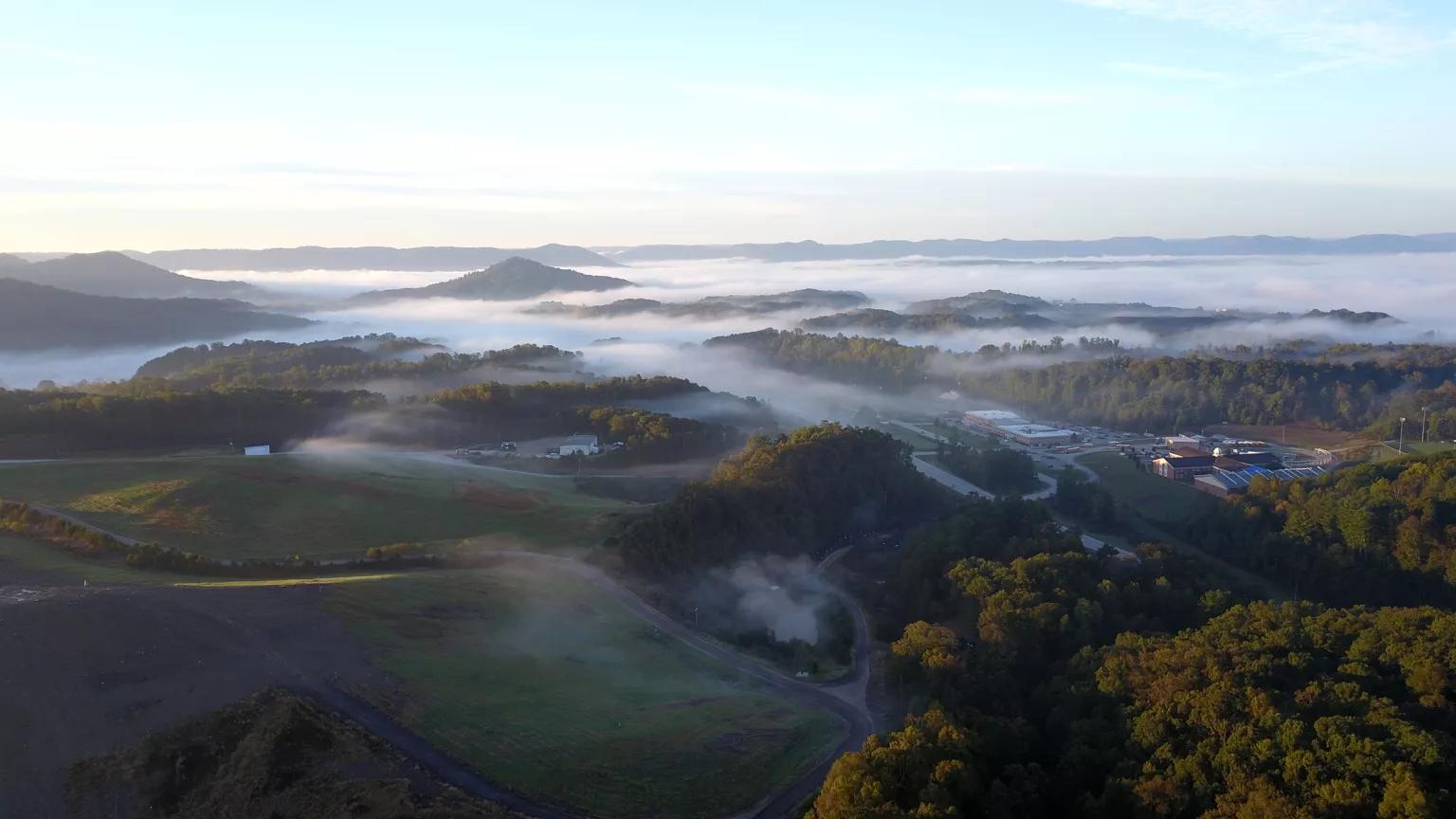
In Irvine, Kentucky, Advanced Disposal's Blue Ridge Landfill (at left) sits in close proximity to the Estill County Middle and High schools.
Logan Jones for onEarth
Estill County isn’t the kind of place you’d think would have a radioactive waste problem. Half of this quiet, unassuming nook of eastern Kentucky is covered like a quilt with farmhouses and churches, while the other half rests in the shade of Daniel Boone National Forest. In Estill’s center, nestled between the Appalachian foothills and the Kentucky River, sits Irvine (population 2,400). Route 89 slices through town as Main Street, crossing the river via a light-green truss bridge on its way to the middle and high schools. Right across the street from the schools, which serve students from all over the county, sits the local landfill.
So when news broke in early 2016 that the local landfill had for months been illegally burying 1,900 tons of radioactive—and potentially carcinogenic—material, this tight-knit community was shocked.
“It’s an insult to the intelligence of the people who live here,” says Nancy Farmer, a lifelong resident who spent 34 years on the Estill County Board of Education. “It’s certainly insulting that life in Estill County is being valued less than life anywhere else, because they’re willing to put this kind of material close to students in two different schools.”
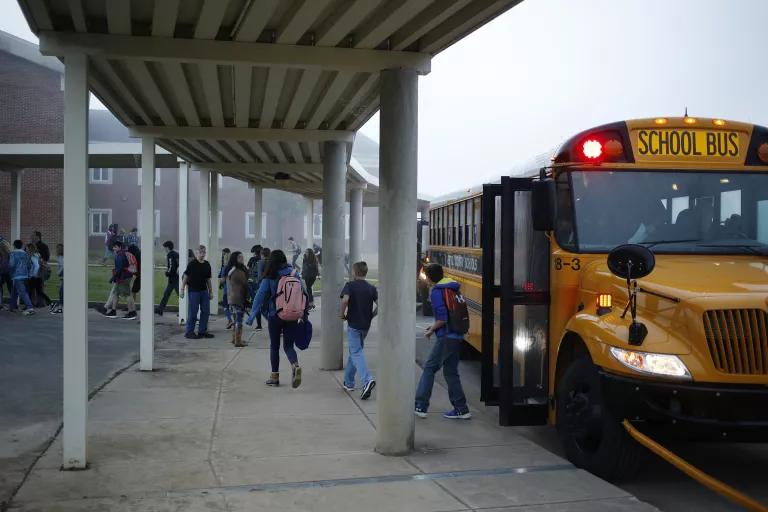
Students arrive for classes at the Estill County Middle School, October 2018.
Luke Sharrett for onEarth
Farmer has never liked the landfill being there. She remembers being concerned when Advanced Disposal, the country’s fourth-largest solid waste disposal corporation, bought the piece of former farmland, and she has worried ever since about the health of the town, the students, and her six grandchildren. After the Blue Ridge Landfill opened in 1984, Farmer drove by it nearly every day on her way to Estill County High School, where she was a biology and English teacher.
“We watched it being built. We smelled it being built,” she says, her red hair curling above a green T-shirt as her elbows rest on a table in the local Hardee’s. “We were concerned about the environmental impact of the landfill from the get-go.”
In 1995, Farmer volunteered to help create a legally binding Host Community Agreement between the county and the landfill owners. As a solid waste facility, the Blue Ridge Landfill could take neither ash residue from a nearby nerve gas and blister gas storage facility (where around 2 percent of our country’s chemical weapons have been kept since 1942) nor radiological waste from anywhere else.
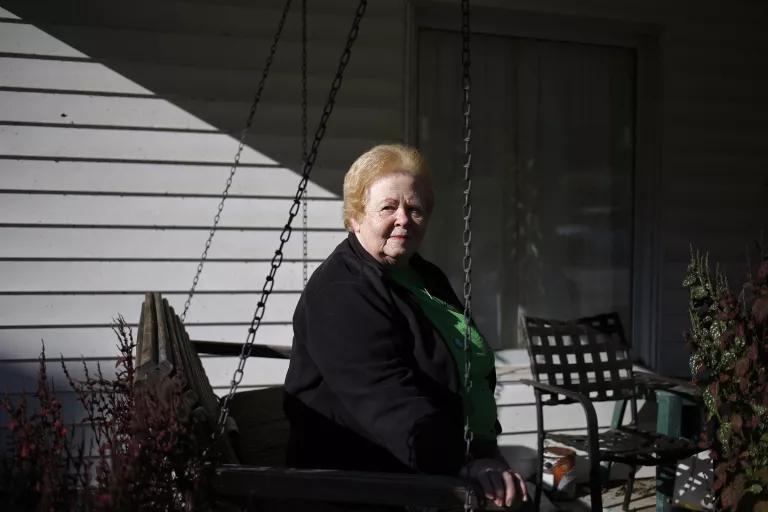
Nancy Farmer, who spent 34 years on the Estill County Board of Education, says her community will not just sit back and let the landfill threaten their health.
Luke Sharrett for onEarth
Only a couple of years passed before Blue Ridge began threatening to undercut the agreement and profit from accepting 90,000 tons of soil and pipes containing naturally occurring radioactive materials, or NORMs, from an old oil field. In response, Farmer and other community members filed a lawsuit in 1997. She attended meetings in Frankfort, the state capital, trying to persuade the Energy and Environment Cabinet (EEC) to keep the waste out of Irvine, while her neighbors protested back home.
“I remember ministers and mothers picketing the landfill when that happened,” Farmer says. “They stood across the road from the landfill on the property of the middle school and high school.”
It worked. By the end of the summer, the landfill withdrew its state permit to accept radioactive waste and the county dropped its suit.
But two decades later, the landfill began illegally accepting radioactive waste anyway. This time it was fracking leftovers sent across state lines from West Virginia and Ohio. For three years the radioactive waste has sat within a few hundred feet of the schools, and the town is locked in battle over what to do with it.
The Origin Story
The waste’s journey to Estill County was a long and complicated one that started miles beneath the earth’s crust. There, radioactive isotopes occur naturally in the bedrock, especially in the Marcellus Shale formation that stretches from West Virginia to New York. After drilling a well, fracking operators forcefully flush a cocktail of water, sand, and chemicals into it in order to crack open the rock and release oil and gas. This wastewater slurry, along with any sediment left on equipment or unearthed during the drilling process, can contain radioactive materials that require special disposal.
More than half of the radioactive waste in Estill’s Blue Ridge Landfill came from a water recycling facility in West Virginia called Fairmont Brine Processing, LLC (which eventually settled with the state of Kentucky for $168,000 for its part in the dumping scandal). Though recycling fracking wastewater is one of the most environmentally responsible solutions for fracking waste (better than injecting it back into the ground, for instance), it creates a new problem: The impurities removed from the wastewater become a concentrated solid known as TENORM, which stands for “technologically enhanced naturally occurring radioactive material.” “It’s kind of like the difference between moonshine and aged whiskey,” explains Farmer. “Moonshine’s like TENORM. It’s concentrated. It has a higher alcohol content.”
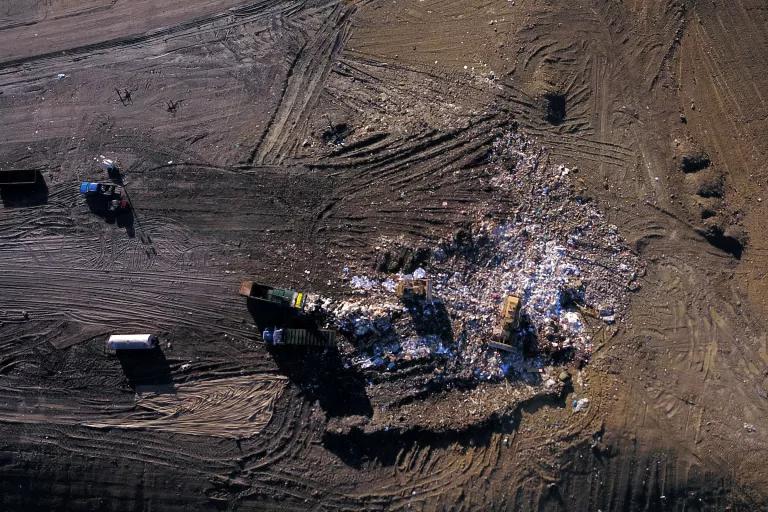
The radioactive waste was likely spread across the Blue Ridge Landfill site, complicating potential cleanup efforts.
Logan Jones and Luke Sharrett for onEarth
Avner Vengosh, professor of earth and ocean sciences at Duke University, calls facilities like Fairmont “enrichment factories for the radioactive element.” In the past, Fairmont may have just disposed of its TENORM in a West Virginia landfill—but in 2015, the state began requiring radiation monitors for all of its solid waste landfills. The new law made it harder for any “drill cuttings and drilling waste” above the state’s radiation limit to be sneaked into landfills not equipped to handle it.
Recycling facilities receive proposals from various landfills and landfill brokers to handle their leftover materials. In the case of Fairmont, Cory Hoskins, who owns BES LLC and Advanced TENORM Services LLC, won the bid. Hoskins brokered a deal with the Blue Ridge Landfill to take the waste—despite Kentucky state law forbidding the acceptance of radioactive waste from West Virginia. The state fined Hoskins’s company $5.3 million, and Advanced Disposal, the landfill’s owner, paid a $95,000 civil penalty.
According to Mark Nighbor, vice president of marketing and communications at Advanced Disposal, the material was disposed of “in accordance with applicable state and federal law and regulation.” His company claims it didn’t know the materials were radioactive, but the manifests between Hoskins and Billy Bowles, the former landfill manager, suggest otherwise.
In the summer of 2015, Bowles accepted eight shipments of waste from Hoskins, who had contracts not only with Fairmont but also with at least eight other oil and gas wastewater companies, including six from Ohio. Through a different broker, Bowles also accepted 36 loads of potentially radioactive waste from Ohio’s Pressure Tech, Inc., described as “a dewatering facility that accepts various slurry from the oil and gas industry.” All of the manifests signed by Bowles describe the shipments along the lines of “Exploration and Production Waste Solids and Debris” or “Exploration and Production Soil and Filter Socks.”
Filter socks— large, sock-shaped bags that filter radioactive materials—have garnered more media attention than other drilling waste byproducts because they are frequently mishandled. And according to the Western Organization of Regional Councils, a network of nonprofits working to make economic development more sustainable, operators use the socks over and over again to condense sludges, “resulting in a highly concentrated radioactivity level.” Managers at the Coral Creek Landfill in Montana, for instance, say the socks “always exceed the analytical limits” for radioactivity. Although that landfill will accept TENORMs, it draws the line at filter socks.
Blue Ridge, which isn’t supposed to be accepting any radioactive materials at all, accepted as many as 62 truckloads containing filter socks. And in the section of the manifests where it asks whether any necessary state approvals have been granted, the “N/A” column, for “non-applicable,” was checked all 62 times. By February 2016 a total of approximately 92 trucks from Fairmont and other TENORM generators had dumped their contents at Blue Ridge.
Orphan Waste
“In the history of the United States, we’ve never knowingly buried massive quantities of low-level radioactive waste in the local garbage dump,” says Bill Hughes, a former chairman of the Wetzel County Solid Waste Authority in West Virginia.
And yet, with more than two decades of experience in the waste business, Hughes wasn’t surprised when he heard that radioactive materials from his state had crossed the border into Kentucky. Because federal law does not require fracking waste to be “monitored cradle to grave,” he says, it can be misplaced, or conveniently forgotten about, in transit. It becomes “orphan waste.”
“The oil and gas industry generates a ton of waste—it’s their Achilles’ heel, if you will—and there simply aren’t enough places to dispose of it,” says Melissa Troutman, a research and policy analyst at Earthworks, a nonprofit working to reform the mining and energy industries. Between 2007 and 2016, natural gas production in the United States increased eightfold; in 2012 alone, fracking nationwide produced upwards of 280 billion gallons of wastewater. That’s a lot to keep track of—especially when nobody is making certain that you do. “There is a bit of a race to the bottom with regard to where companies send their waste,” says Troutman.
The rules for disposing of oil and gas waste vary from state to state. While the federal government regulates hazardous waste under the Resource Conservation and Recovery Act (RCRA), the oil and gas industry takes advantage of loopholes that exempt most of the 18 billion barrels of waste fluids it generates annually. For instance, fracking leftovers—even the radioactive kind—fall into the “nonhazardous” category, along with household waste. “It’s all political,” says Vengosh, who believes the law should consider all oil and gas waste, including fracking wastewater, hazardous.
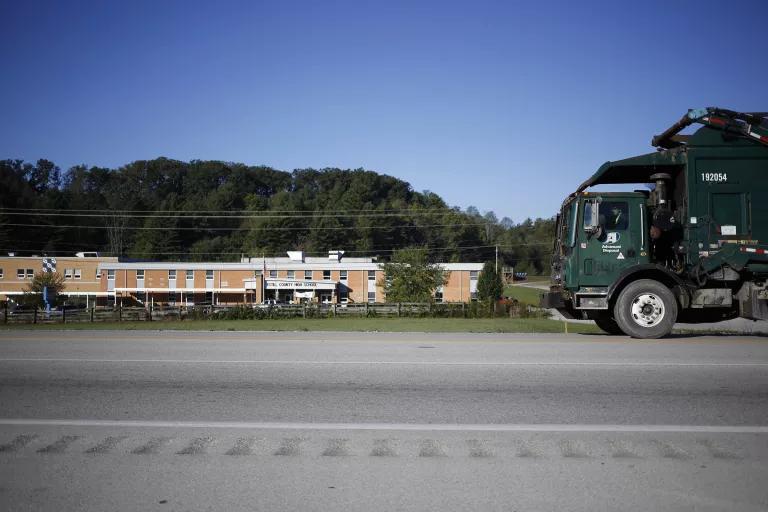
Trash trucks roar past the two schools daily on their way to and from the landfill across the road.
Luke Sharrett for onEarth
The U.S. Environmental Protection Agency (EPA) has minimum standards for oil and gas waste disposal, but “it’s up to the states to conduct enforcement and permitting,” says Adam Kron, a lawyer with the Environmental Integrity Project, a watchdog group that monitors the enforcement of environmental laws. When the EPA passed RCRA in 1988, the agency promised to revisit its waste guidelines, but 30 years have passed and it has yet to do so. The Environmental Integrity Project, along with NRDC and other groups, sued the EPA in 2015; the result was a settlement requiring the agency to decide whether to strengthen its waste standards by March of this year.
Kron is hopeful that the EPA will step up and pass stricter regulations but realizes it’s an unlikely scenario under the Trump administration, which seems to be more interested in rolling back environmental protections. If fossil fuel wastes continue to go unregulated, Kron says, “they’re going to end up in the cheapest place. It winds up on the doorstep of folks with the least political power to fight back.”
To Cap or Not to Cap
In the meantime, the residents of Estill County have a decision to make. Blue Ridge submitted a corrective action plan to Kentucky’s EEC in 2015 proposing two options for dealing with its radioactive waste: remove it or cap it in the ground. The EEC opted for a cap, saying leaving the radioactive material where it lies would be the best “short-term” solution, providing the greatest protection to human health and the environment.
“We understand people who say, ‘We didn’t want this stuff brought in,’ ” says John Mura, director of communications for the EEC. “That it shouldn’t [have been] brought in, and now they want it removed. But it’s the opinion of a lot of thoughtful engineering that the safest thing to do is cap it.”
Not everyone feels that way. Craig Williams, program director for the Kentucky Environmental Foundation, a health-focused environmental nonprofit, says none of the investigations into the Estill waste actually tested the waste in question. Instead they looked at samples from Fairmont, taken months later. “To rely on conclusions regarding the hazards posed to the public and the environment without actual samples being taken is irresponsible and ludicrous,” says Williams.
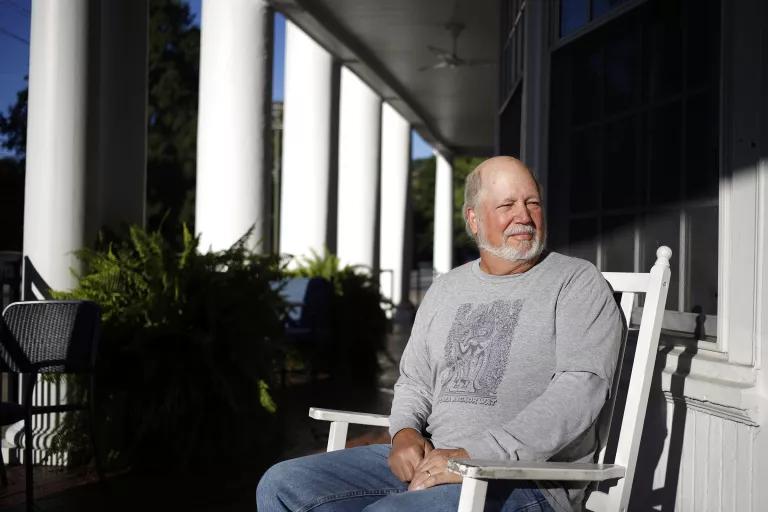
In addition to health concerns, many Estill residents worry about long-term economic impacts of having a toxic waste site in their community, says Craig Williams, director of the Kentucky Environmental Foundation.
Luke Sharrett for onEarth
Another concern is leachate, the water that moves through the layers of a landfill like hot water percolating through coffee grounds. A water treatment plant in Irvine treats Blue Ridge’s leachate before releasing it into the Kentucky River. After the discovery of the illegal dumping, Irvine Municipal Utilities twice tested the plant’s storage tank and waste products for radium 226, the isotope most likely to be found in the Blue Ridge waste. The results came back normal both times, but that doesn’t mean the dangerous materials couldn’t find their way out of the landfill in the future. When submitting its risk assessment of capping the waste in place, Blue Ridge Landfill described a worst-case scenario of the radiation contaminating groundwater for the next 2,700 years.
The leachate makes the location of the landfill particularly troubling. “One side drains to Calloway Creek, which enters the Kentucky River beyond the high school, and the other half drains into White Oak Creek, which also enters the river,” explains Farmer. All told, residents in about 42 counties pull almost 100 million gallons of water from the Kentucky River basin each day. It’s part of a watershed ultimately draining northwest to the Ohio River. “It’s not just little old Estill County and the 15,000 people who live here. It has the potential to harm all the people in central Kentucky,” Farmer says.
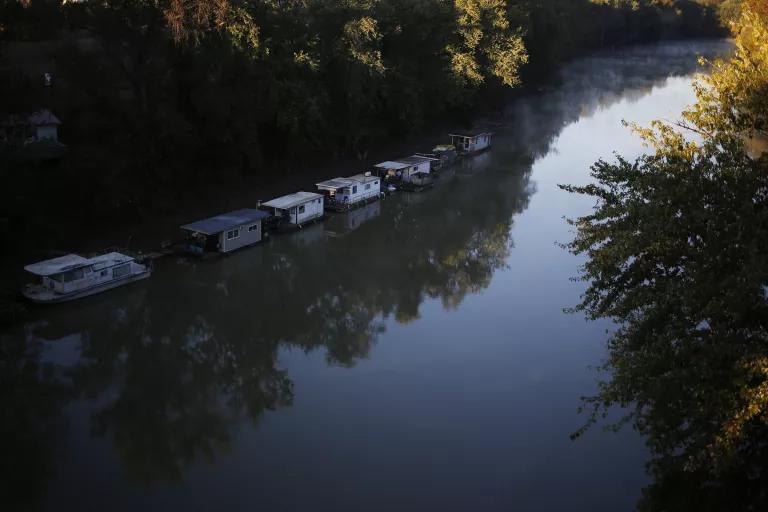
At least 185 factories, municipalities, and other entities draw from the Kentucky River, located a third of a mile from the Blue Ridge Landfill.
Luke Sharrett for onEarth
“If the landfill isn’t lined, the radioactive material could become part of the groundwater,” says Vengosh. “There are so many pathways by which unregulated and unprotected contaminants in a landfill could migrate into local streams and groundwater.” The Blue Ridge Landfill does have a liner, but it will likely last only 450 years—thousands of years less than the half-lives of the radioactive materials it contains.
The second option, digging up the waste and sending it elsewhere, comes with its own problems. According to Mura, these include exposing workers to radiation during removal, kicking up potentially dangerous dust in the process, and figuring out where in the seven-acre landfill to look for it.
The location of the radioactive waste is still unclear, and “the way landfills work, it’s most likely that the material did not . . . stay in one place,” says Mura. “You may have to dig up a substantial part of the landfill,” he says, “and then would you know if you got it all?”
According to case documents, the TENORM was used as “alternate daily cover,” which means it was used in place of soil to cover the landfill at the end of the day, even though Blue Ridge was “not authorized for such alternate daily cover,” because, again, it was not a hazardous waste landfill.
Blue Ridge’s removal plan would also require that nearly 1,900 truckloads of waste be transferred and would take an estimated three months, resulting in more noise and traffic in the community and an increased risk for accidental collisions and spills.
But according to Vengosh, these risks are overblown. “There’s no human health hazard if people are taking correct protection from dust and exposure to be able to carry it. It should be done without much impact.”
Such waste removals are already being done nationwide. The U.S. Department of Energy reported transporting more than 15,000 shipments of low-level radioactive waste along U.S. highways in 2015—with no recorded packaging or transportation accidents.
The more likely barrier, says Gretchen Goldman, research director for the Union of Concerned Scientists, a nonprofit science advocacy organization, is that “it’ll be costly.” While the estimated costs for capping the waste would total just under $300,000, the bill for removing it would come in at more than $6 million.
Not Without a Fight
After months of attending public hearings and leaving public comments, the Concerned Citizens of Estill County filed a petition this past June for the state to reconsider its acceptance of Blue Ridge’s proposal to cap the waste.
“There are many people [in Estill County] who feel they’re already in an economically struggling region of the country,” says Williams. “They’re trying to attract businesses and increase land prices. This situation is contrary to those desires, and they fear land values will go down.”
The Concerned Citizens group, which formed shortly after the waste’s discovery and which successfully sued the state attorney general’s office for the release of documents concerning the landfill, expects a decision on the petition by April 2019. It’s a long shot, but for Farmer, seeing her community advocate for itself is the silver lining.
“I think it’s a good thing that people here in the county are not willing to sit here and be silent,” she says. “We’re saying we have to be on guard. We can’t just sit here and be pawns.”
This article was originally published on onEarth, which is no longer in publication. onEarth was founded in 1979 as the Amicus Journal, an independent magazine of thought and opinion on the environment. All opinions expressed are those of the authors and do not necessarily reflect the policies or positions of NRDC. This article is available for online republication by news media outlets or nonprofits under these conditions: The writer(s) must be credited with a byline; you must note prominently that the article was originally published by NRDC.org and link to the original; the article cannot be edited (beyond simple things such grammar); you can’t resell the article in any form or grant republishing rights to other outlets; you can’t republish our material wholesale or automatically—you need to select articles individually; you can’t republish the photos or graphics on our site without specific permission; you should drop us a note to let us know when you’ve used one of our articles.
The Ohio River Defines the Borders of Five States—But Its Pollution Doesn’t Stop at State Lines
The Connection Between Mass Incarceration and Environmental Justice
The Petcoke Problem: Where to Store the Risky Tar Sands Refining By-Product